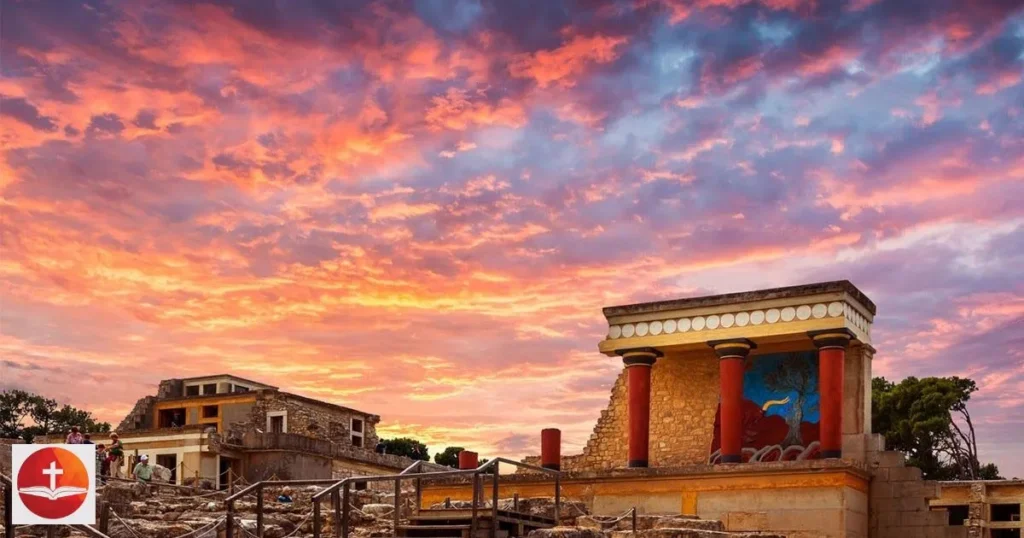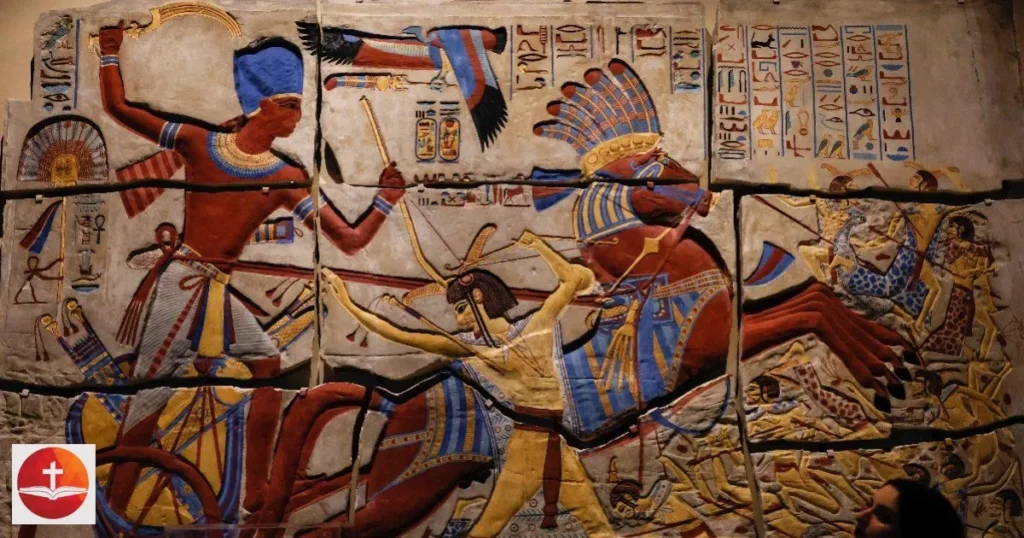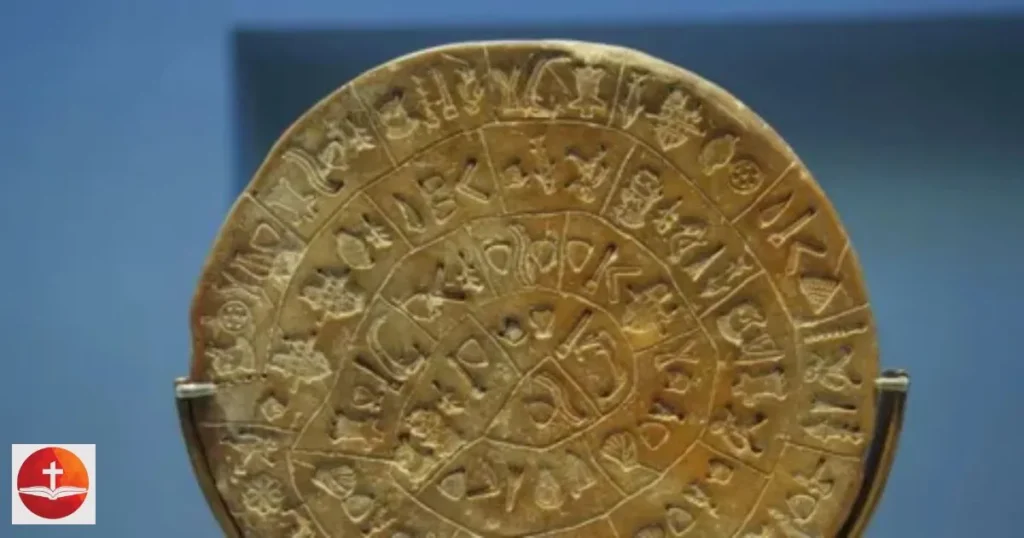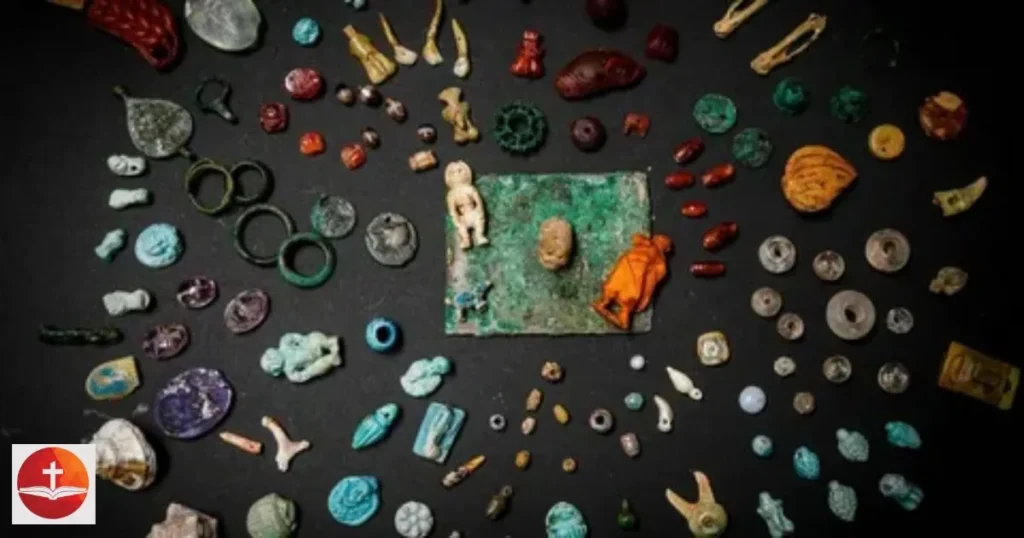“An ancient enigma that continues to baffle scholars and ignite the imagination.”
The Phaistos Disk is one of archaeology’s most enigmatic artifacts, discovered in the Minoan palace of Phaistos on the island of Crete. Dating back to around 1700 BC, this clay disk is inscribed with a unique and undeciphered script.
The disk’s mysterious symbols have puzzled scholars for over a century, leading to various theories and interpretations. In this article, we will delve into the history, significance, and possible meanings of the Phaistos Disk.
By exploring its context and the ongoing efforts to decode its script, we can better understand this ancient enigma.
Historical Context of the Phaistos Disk
The Phaistos Disk was discovered in 1908 by Italian archaeologist Luigi Pernier during an excavation at the Minoan palace of Phaistos. The Minoan civilization, known for its advanced architecture and vibrant art, flourished on Crete during the Bronze Age. The disk, with its spiral arrangement of symbols, is a rare example of a potentially unique writing system from this period.
Scholars believe that the disk may have had religious or ceremonial significance. The purpose and origin of the symbols remain unclear, but the disk offers a glimpse into the complexity of Minoan society.
Scripture: “The Minoans spoke, and their words were preserved in symbols, yet the meaning remains hidden, awaiting revelation.”
Prayer: “Lord, as we seek to uncover the mysteries of the past, grant us wisdom and insight. May we honor the knowledge of those who came before us.”
Prayer: “Heavenly Father, guide our understanding of ancient cultures and their messages. Help us to learn and grow from the wisdom they left behind.”
The Mysterious Symbols on the Disk
The symbols on the Phaistos Disk are arranged in a spiral, with 45 distinct signs repeated in various sequences. These symbols have no known parallels in other writing systems, making the disk’s script truly unique. Some researchers suggest that the symbols may represent syllables or words, while others believe they might be pictograms conveying ideas or objects.
Despite extensive study, the exact meaning of these symbols remains elusive. Scholars have proposed that the disk could be a prayer, hymn, or legal document. Each symbol is carefully imprinted into the clay, indicating that the disk may have held significant meaning for its creators.
Scripture: “The symbols on the disk speak in silence, a language lost to time but still resonant with mystery.”
Prayer: “Lord, as we study the signs of the past, grant us patience and understanding. May we find the truth hidden in the ancient script.”
Prayer: “God, we pray for clarity as we decipher the messages left by our ancestors. Illuminate the path to knowledge and understanding.”
Top Christian Movies: Must-Watch Films for Inspiration
Theories and Interpretations of the Disk
Over the years, numerous theories have been proposed to explain the purpose and meaning of the Phaistos Disk. Some suggest that it was a religious artifact, used in rituals or prayers. Others believe it could be a record of a legal agreement or a calendar marking important events. The diversity of interpretations highlights the disk’s complexity and the challenges of deciphering ancient scripts.
One of the most intriguing theories is that the Phaistos Disk is a form of proto-writing, representing an early stage in the development of a writing system. This theory suggests that the disk’s symbols were part of a larger, now-lost tradition of Minoan writing.
Scripture: “Theories abound, yet the truth of the symbols remains locked, awaiting the one who will see clearly.”
Prayer: “Lord, in our quest to uncover the past, guide us to the truth. May we approach these ancient mysteries with humility and respect.”
Prayer: “Heavenly Father, as we explore the unknown, grant us the wisdom to discern truth from speculation. May our studies honor the legacy of those who came before us.”
The Role of the Disk in Minoan Culture

The Phaistos Disk is not just an isolated artifact; it is a window into the culture and beliefs of the Minoan people. The Minoans were known for their artistic achievements, complex religious practices, and advanced society. The disk’s symbols may reflect the values and traditions of this civilization, offering insights into their worldview.
Understanding the disk’s role in Minoan culture requires considering it within the broader context of Minoan art and writing. The symbols on the disk are unique, yet they may share connections with other forms of Minoan iconography and script. The disk could represent a sacred text or a ceremonial object, integral to Minoan religious life.
Scripture: “In the symbols of the disk, we glimpse the heart of a culture, its beliefs and hopes etched in clay.”
Prayer: “Lord, as we study the artifacts of ancient cultures, help us to see beyond the surface. May we understand the deeper meaning behind their creations.”
Prayer: “God, guide our exploration of the past, and may we honor the traditions and beliefs of those who lived long before us.”
The Ongoing Mystery of Decipherment

Despite over a century of research, the Phaistos Disk remains undeciphered. The lack of comparable texts or inscriptions has made it difficult for scholars to crack the code. Some have attempted to link the symbols to Linear A or Linear B, other Minoan scripts, but these efforts have yet to yield conclusive results.
The ongoing mystery of the Phaistos Disk serves as a reminder of the limitations of modern scholarship and the enduring power of ancient mysteries. The disk continues to inspire both professional archaeologists and amateur enthusiasts, each hoping to be the one to finally decode its script.
Scripture: “The mystery endures, a puzzle of the past that challenges the minds of today, waiting for the one who will see.”
Prayer: “Lord, as we strive to unlock the secrets of history, give us the perseverance to continue our search. May we approach these mysteries with curiosity and care.”
Prayer: “Heavenly Father, we ask for guidance in our quest to understand the unknown. May our efforts bring us closer to the truth.”
The Significance of the Phaistos Disk
The Phaistos Disk is more than just an archaeological curiosity; it represents the ingenuity and creativity of the Minoan civilization. Its unique script and mysterious symbols offer a tantalizing glimpse into the intellectual and spiritual life of ancient Crete.

The significance of the disk lies in its ability to connect us with the past. It challenges us to think critically about the nature of writing, language, and communication. By studying the Phaistos Disk, we gain insight into the broader history of human expression.
Scripture: “The disk speaks across the ages, a message from the past that still resonates with those who seek to understand.”
Prayer: “Lord, we thank You for the treasures of the past that enrich our understanding of the present. Help us to preserve and honor these ancient artifacts.”
Prayer: “God, as we reflect on the significance of the Phaistos Disk, may we be inspired by the creativity and intelligence of those who came before us.”
The Phaistos Disk and Modern Research

Modern technology and new methodologies have renewed interest in the Phaistos Disk. Advances in linguistics, computer analysis, and 3D imaging have provided new tools for studying the disk, offering fresh perspectives on its script.
Researchers continue to explore the disk’s symbols, hoping to uncover connections with other ancient scripts or to develop new theories about its meaning. The Phaistos Disk remains a fascinating subject of study, attracting scholars from diverse fields, all united in their quest to unlock its secrets.
Scripture: “In the light of new knowledge, the ancient disk reveals more of its secrets, yet much remains to be understood.”
Prayer: “Lord, as we apply modern knowledge to ancient mysteries, guide our research and inspire our discoveries. May we honor the wisdom of the past.”
Prayer: “Heavenly Father, bless our efforts to understand the ancient world through the lens of modern technology. May our work lead to new insights and deeper appreciation of history.”
The Legacy of the Phaistos Disk

The Phaistos Disk has left an indelible mark on the field of archaeology. Its discovery sparked debate, curiosity, and a renewed interest in Minoan civilization. The disk remains one of the most discussed and analyzed artifacts in the study of the ancient world.
The legacy of the Phaistos Disk is one of enduring mystery and inspiration. It continues to challenge our understanding of ancient writing systems and encourages us to explore the limits of our knowledge. The disk serves as a reminder of the complexity and richness of human history.
Scripture: “The legacy of the disk endures, a testament to the creativity and mystery of a civilization long gone.”
Prayer: “Lord, we give thanks for the discoveries that deepen our understanding of history. May we continue to seek knowledge with humility and respect.”
Prayer: “God, as we reflect on the legacy of the Phaistos Disk, inspire us to pursue the truth and to appreciate the mysteries that remain.”
The Phaistos Disk: A Mysterious Ancient Artifact

The Phaistos Disk is an enigmatic artifact discovered on the island of Crete in 1908. Dating back to around 1700 BCE and associated with the Minoan civilization, it has baffled archaeologists and historians for over a century. The disk is made of fired clay, measures about 15 cm (5.9 in) in diameter, and is inscribed with a spiral of symbols on both sides. Despite extensive study, the disk’s purpose and the meaning of its inscriptions remain a mystery.
The Unique Writing System of the Phaistos Disk
One of the most intriguing aspects of the Phaistos Disk is its undeciphered writing system. The disk contains 241 symbols, with 45 distinct signs, many of which appear to represent human figures, animals, tools, and plants. These symbols were stamped into the clay in a spiral, suggesting some form of mass production. However, no other similar disks have been found, making it a unique find in archaeology.
Theories and Interpretations
Scholars have proposed various theories about the Phaistos Disk, ranging from it being a religious artifact, a calendar, or a form of proto-writing. Some have attempted to link its symbols to known writing systems like Linear A or Linear B, but no definitive connections have been made. Theories also suggest it could be an early form of pictographic writing used for ceremonial or ritualistic purposes.
The Role of Ancient Writing Systems
The Phaistos Disk contributes to the broader understanding of ancient writing systems, though it remains undeciphered. During the same period, other important writing systems were emerging across the ancient world:
- Cuneiform: Developed by the Sumerians around 3200 BCE in Mesopotamia, cuneiform is one of the earliest known writing systems. It involved pressing wedge-shaped marks into clay tablets.
- Egyptian Hieroglyphs: Used by ancient Egyptians, hieroglyphs were a pictorial writing system used for religious and administrative purposes, emerging around 3000 BCE.
- Linear A and Linear B: Linear A, the undeciphered script of the Minoan civilization, is often compared to the symbols on the Phaistos Disk. Linear B, deciphered in the 1950s, was used by the Mycenaeans to record an early form of the Greek language.
The Ongoing Mystery of the Phaistos Disk
Despite many attempts to interpret the Phaistos Disk, its meaning remains elusive. The lack of any similar artifacts and the undeciphered nature of its symbols leave it as one of the most puzzling relics of the ancient world. Scholars continue to debate its purpose, leaving open the possibility that one day its secrets might be revealed.
Conclusion
The Phaistos Disk remains one of the greatest unsolved mysteries of the ancient world. Its unique script and mysterious symbols offer a tantalizing glimpse into the intellectual and spiritual life of the Minoan civilization.
Despite extensive study, the exact meaning of the disk’s symbols remains elusive, and the disk continues to inspire both professional archaeologists and amateur enthusiasts. The legacy of the Phaistos Disk is one of enduring mystery and inspiration.
It challenges us to think critically about the nature of writing, language, and communication, and it encourages us to explore the limits of our knowledge.
Scripture: “The mystery endures, a puzzle of the past that challenges the minds of today, waiting for the one who will see.”
Prayer: “Lord, as we strive to unlock the secrets of history, give us the perseverance to continue our search. May we approach these mysteries with curiosity and care.”
Prayer: “Heavenly Father, we ask for guidance in our quest to understand the unknown. May our efforts bring us closer to the truth.”

Hi! I’m James Whitman, the admin of Bible Pulze. I have a deep passion for sharing the wisdom and teachings of the Bible. Through our website, I aim to make the scriptures more accessible and engaging for everyone. Whether you’re looking for inspiration, guidance, or a deeper understanding of the Bible, I’m here to help you on your spiritual journey.

